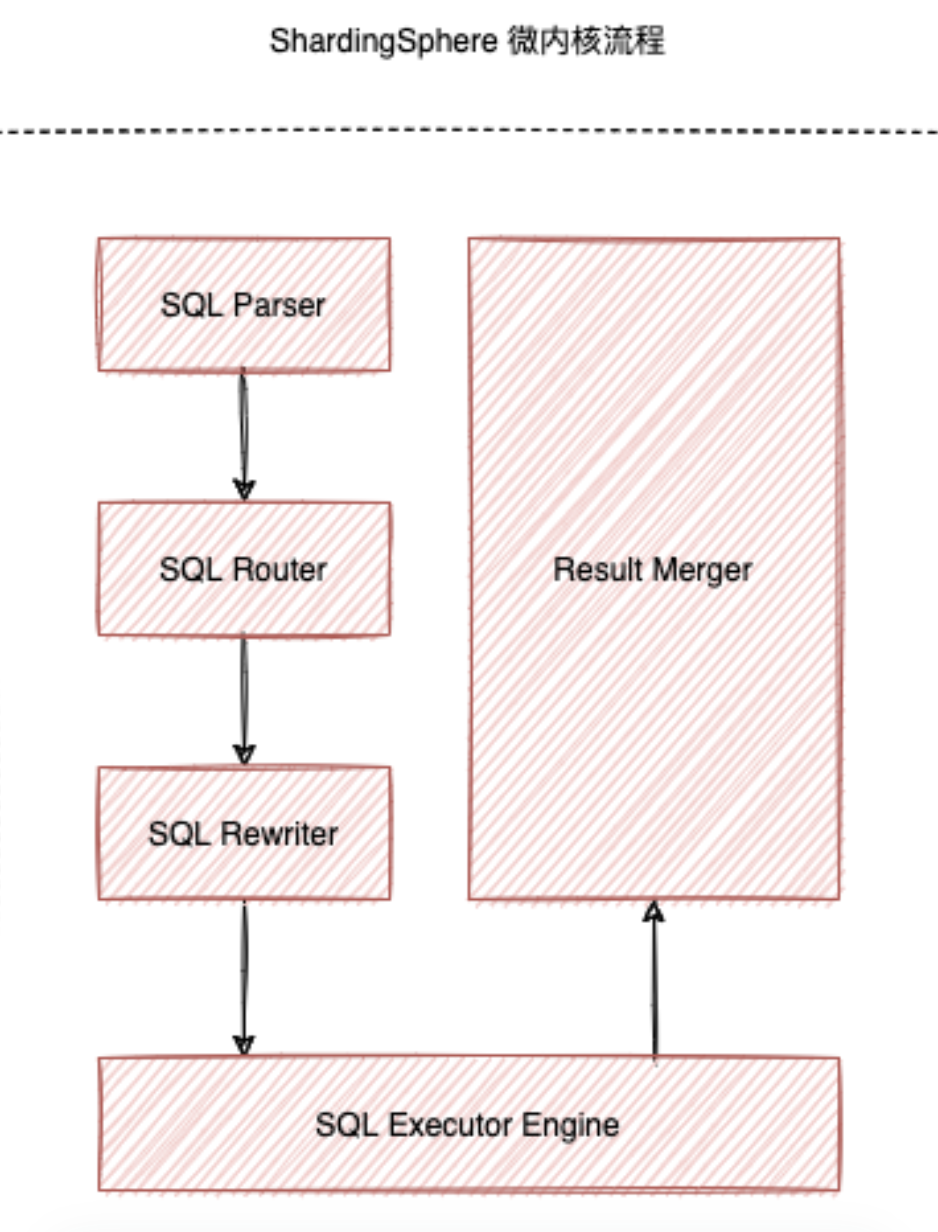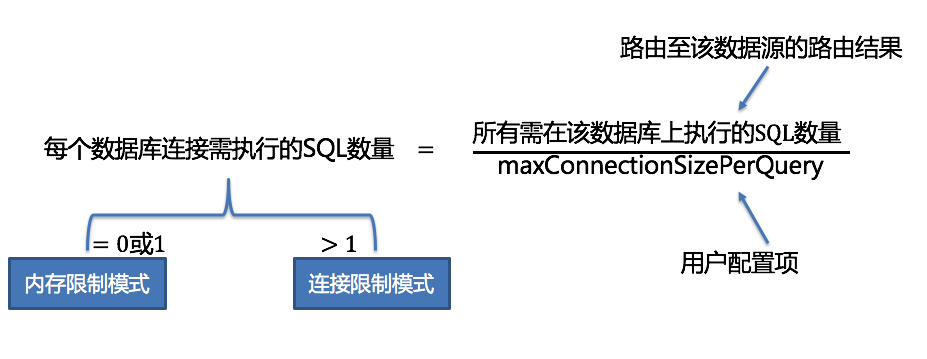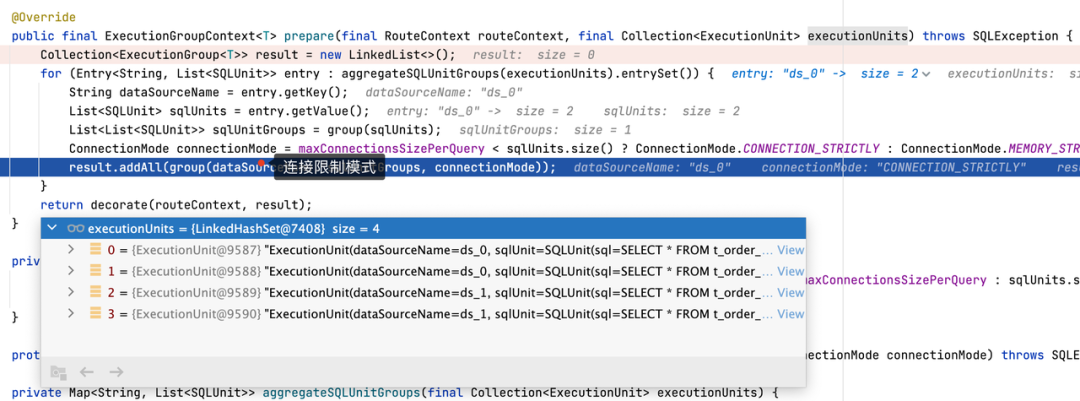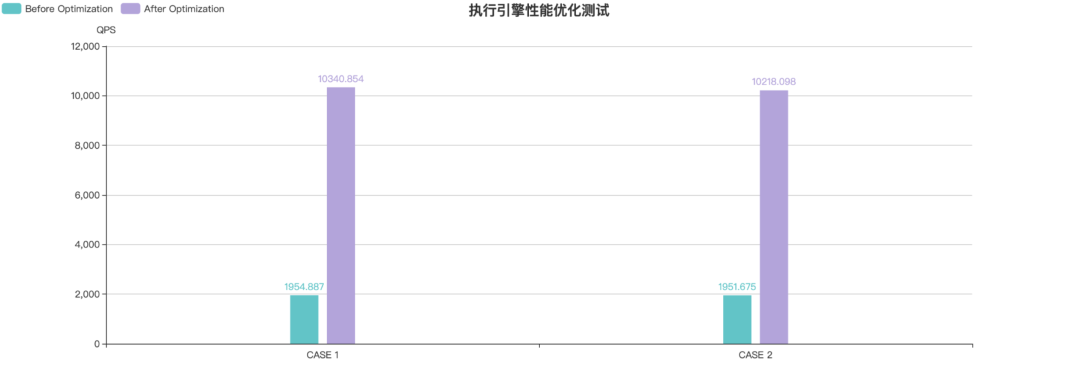
SphereEx 高级中间件开发工程师,Apache ShardingSphere Committer。
2018 年开始接触 Apache ShardingSphere 中间件,曾主导公司内部海量数据的分库分表,有着丰富的实践经验;热爱开源,乐于分享,目前专注于 Apache ShardingSphere 内核模块开发。
前言
在 Apache ShardingSphere 5.1.0 前几篇技术解读文章中,我们了解了解析引擎提供的 SQL 格式化功能,以及最新优化的高可用功能。除了不断为用户提供实用的新特性外,Apache ShardingSphere 社区一直在努力提升性能。
以单库 10 分片的 t_order
表为例,max-connections-size-per-query
使用默认配置 1,如果用户执行 SELECT * FROM t_order
语句则会导致全路由。由于每个查询只允许在同一个数据库上创建一个数据库连接,因此底层真实执行的 SQL 结果会被提前加载至内存进行处理,该场景限制了数据库连接资源的消耗,但是会占用更多的内存资源。如果用户将 max-connections-size-per-query
调整为 10,则可以在执行真实 SQL 时,同时创建 10 个数据库连接,由于数据库连接能够持有结果集,因此该场景不会额外占用内存资源,但是很显然会消耗更多的数据库连接资源。
为了更好地解决数据库连接资源和内存资源占用的问题,在刚刚发布的 5.1.0 版本中,我们对 SQL 执行引擎的性能进行了优化,通过 SQL 改写引擎进行优化性改写,将同一个数据源上的多条真实 SQL,使用 UNION ALL 语句进行合并,从而有效降低了执行引擎对数据库连接资源的消耗,同时减少了内存归并的发生,大幅度提升了 OLTP 场景下 SQL 查询性能。下面我们将结合具体的 SQL 实例,为大家详细解读执行引擎性能优化的细节。
执行引擎原理
在解读执行引擎性能优化之前,让我们先来回顾下 Apache ShardingSphere 微内核及内核流程中执行引擎的原理。如下图所示,Apache ShardingSphere 微内核包含了 SQL 解析、SQL 路由、SQL 改写、SQL 执行和结果归并等核心流程。

从整个微内核的执行流程可以看出,SQL 执行引擎直接与底层数据库交互,并负责持有执行的结果集,可以说执行引擎的性能和资源消耗,直接关系到整个 Apache ShardingSphere 的性能和资源消耗,因此 Apache ShardingSphere 内部采用了一套自动化的 SQL 执行引擎,负责在执行性能和资源消耗间进行权衡。
从执行性能的角度来看,为每个分片的执行语句分配一个独立的数据库连接,可以充分利用多线程来提升执行性能,也可以将 I/O 所产生的消耗并行处理。此外,为每个分片分配一个独立的数据库连接,还能够避免过早的将查询结果集加载至内存,独立的数据库连接,能够持有查询结果集游标位置的引用,在需要获取相应数据时移动游标即可。
从资源控制的角度来看,应当对业务访问数据库的连接数量进行限制,避免某一业务占用过多的数据库连接资源,影响其他业务的正常访问。特别是在一个数据库实例中存在较多分表的情况下,一条不包含分片键的逻辑 SQL 将产生落在同库不同表的大量真实 SQL,如果每条真实 SQL 都占用一个独立的连接,那么一次查询无疑将会占用过多的资源。
为了解决执行性能和资源控制的冲突问题,Apache ShardingSphere 提出了连接模式的概念,下面是 Apache ShardingSphere 源码对于连接模式的定义。
/**
* Connection Mode.
*/
public enum ConnectionMode {
MEMORY_STRICTLY, CONNECTION_STRICTLY
}复制
从 ConnectionMode 枚举类中成员的命名可以看出,SQL 执行引擎将数据库连接划分为 MEMORY_STRICTLY
和 CONNECTION_STRICTLY
。
MEMORY_STRICTLY
代表内存限制模式,当采用内存限制模式时,对于同一个数据源,如果逻辑表对应了 10 个真实表,那么 SQL 执行引擎会创建 10 个连接并行地执行,由于每个分片的结果集都有对应的连接进行持有,因此无需将结果集提前加载到内存中,从而有效地降低了内存占用;CONNECTION_STRICTLY
代表连接限制模式,当采用连接限制模式时,SQL 执行引擎只会在同一个数据源上创建一个连接,严格控制对数据库连接资源的消耗,在真实 SQL 执行之后立即将结果集加载至内存,因此会占用部分内存空间。
那么,Apache ShardingSphere SQL 执行引擎是如何帮助用户选择连接模式的呢?SQL 执行引擎选择连接模式的逻辑可以参考下图:

用户通过配置 maxConnectionSizePerQuery
参数,可以指定每条语句在同一个数据源上最大允许的连接数。通过上面的计算公式,当每个数据库连接需执行的 SQL 数量小于等于 1 时,说明当前可以满足每条真实执行的 SQL 都分配一个独立的数据库连接,此时会选择内存限制模式,同一个数据源允许创建多个数据库连接进行并行执行。反之则会选择连接限制模式,同一个数据源只允许创建一个数据库连接进行执行,然后将结果集加载进内存结果集,再提供给归并引擎使用。
执行引擎优化
在熟悉了 Apache ShardingSphere SQL 执行引擎的内部原理之后,我们发现使用内存限制模式时,会消耗更多的数据库连接,但是能够通过并发执行获得更好的性能,使用连接限制模式能够有效控制连接资源的使用,但是会占用过多的内存,执行的性能也会受到影响。
那么,有没有可能使用尽可能少的数据库连接,同时占用较少内存的执行方式呢?根据前文对 SQL 执行引擎的分析,执行模式的选择主要是根据同一个数据源上路由结果的数量,因此最直接的优化思路,就是对同一个数据源上的路由结果进行合并。SQL 语句天然支持通过 UNION ALL 对多条查询语句进行合并,因此我们采用 UNION ALL 方案,对同一个数据源中的多条真实 SQL 进行优化性改写,从而将多条真实 SQL 改写为一条 SQL,这样能够大大减少数据库连接的获取,同时也可以将内存结果集转换为流式结果集,减少内存的占用。
考虑到不同数据库方言对于 UNION ALL 语句的使用存在限制,我们调研了 MySQL、PostgreSQL、Oracle 以及 SQL Server 的官方文档,梳理之后得到了如下信息。
MySQL UNION ALL 使用规范:
UNION 之后的列名使用第一个 SELECT 语句中的列名;
UNION 中包含 ORDER BY 和 LIMIT 时,需要使用括号将各个查询语句括起来,UNION 无法保证最终的结果集有序,如果需要对 UNION 结果集进行排序,需要在 UNION 语句最后添加 ORDER BY LIMIT 子句;
# 无法保证 UNION 结果集有序
(SELECT a FROM t1 WHERE a=10 AND B=1 ORDER BY a LIMIT 10) UNION (SELECT a FROM t2 WHERE a=11 AND B=2 ORDER BY a LIMIT 10);
# 保证 UNION 结果集有序
(SELECT a FROM t1 WHERE a=10 AND B=1) UNION (SELECT a FROM t2 WHERE a=11 AND B=2) ORDER BY a LIMIT 10;复制
UNION 不支持
SELECT HIGH_PRIORITY
语句和SELECT INTO file
语句
PostgreSQL UNION ALL 使用规范:
UNION 之后的列名使用第一个 SELECT 语句中的列名;
UNION 中包含 ORDER BY 和 LIMIT 时,需要使用括号将各个查询语句括起来,最后一个 UNION 子句可以不使用括号,不使用括号,则 ORDER BY LIMIT 子句应用于整个 UNION 结果。
UNION 语句不支持 FOR NO KEY UPDATE、FOR UPDATE、FOR SHARE 和 FOR KEY SHARE;
Oracle UNION ALL 使用规范:
UNION 语句不支持 BLOB, CLOB, BFILE, VARRAY, LONG 类型或者 nested table;
UNION 语句不支持 for_update_clause;
UNION 语句不支持 select 子句中包含 order_by_clause,只能在 UNION 语句最后添加 order_by_clause;
SELECT product_id FROM order_items UNION SELECT product_id FROM inventories ORDER BY product_id;
复制
UNION 语句不支持 SELECT 语句中包含 TABLE collection expressions;
SQL Server UNION ALL 使用规范:
UNION 语句中使用 ORDER BY 子句时,必须放在最后一个 select 子句之上,对 UNION 结果进行排序;
综合以上梳理的信息来看,不同的数据库方言都能够支持简单的 SELECT * FROM table WHERE
语句,对于 ORDER BY LIMIT
也能通过语法调整进行支持,只是使用上存在一些语法差异,而对于更加复杂的分组查询、子查询及关联查询,官方文档上并未进行详细描述。考虑到 SQL 优化性改写需要保证 SQL 兼容性,Apache ShardingSphere 5.1.0 只选择了简单的 SELECT * FROM table WHERE
语句进行改写,旨在快速提升 OLTP 场景下的查询性能。
下面展示了 RouteSQLRewriteEngine 改写引擎的最新逻辑,Apache ShardingSphere 5.1.0 中添加了对于 SELECT * FROM table WHERE
语句的优化性改写逻辑,首先通过 isNeedAggregateRewrite 进行判断,只有当同一个数据源中的路由结果大于 1,并且真实执行的 SQL 满足 SELECT * FROM table WHERE
结构时,才会进行 UNION ALL 改写。
/**
* Rewrite SQL and parameters.
*
* @param sqlRewriteContext SQL rewrite context
* @param routeContext route context
* @return SQL rewrite result
*/
public RouteSQLRewriteResult rewrite(final SQLRewriteContext sqlRewriteContext, final RouteContext routeContext) {
Map<RouteUnit, SQLRewriteUnit> result = new LinkedHashMap<>(routeContext.getRouteUnits().size(), 1);
for (Entry<String, Collection<RouteUnit>> entry : aggregateRouteUnitGroups(routeContext.getRouteUnits()).entrySet()) {
Collection<RouteUnit> routeUnits = entry.getValue();
if (isNeedAggregateRewrite(sqlRewriteContext.getSqlStatementContext(), routeUnits)) {
result.put(routeUnits.iterator().next(), createSQLRewriteUnit(sqlRewriteContext, routeContext, routeUnits));
} else {
result.putAll(createSQLRewriteUnits(sqlRewriteContext, routeContext, routeUnits));
}
}
return new RouteSQLRewriteResult(result);
}复制
由于使用了 UNION ALL 改写,归并引擎中对于 queryResults 的判断逻辑也需要同步进行调整,原先多个 queryResults 可能被 UNION ALL 合并为一个 queryResults,这种场景下仍然需要执行归并逻辑。
@Override
public MergedResult merge(final List<QueryResult> queryResults, final SQLStatementContext<?> sqlStatementContext, final ShardingSphereSchema schema) throws SQLException {
if (1 == queryResults.size() && !isNeedAggregateRewrite(sqlStatementContext)) {
return new IteratorStreamMergedResult(queryResults);
}
Map<String, Integer> columnLabelIndexMap = getColumnLabelIndexMap(queryResults.get(0));
SelectStatementContext selectStatementContext = (SelectStatementContext) sqlStatementContext;
selectStatementContext.setIndexes(columnLabelIndexMap);
MergedResult mergedResult = build(queryResults, selectStatementContext, columnLabelIndexMap, schema);
return decorate(queryResults, selectStatementContext, mergedResult);
}复制
为了方便大家理解优化前后的逻辑,我们使用如下分片配置,通过 SELECT * FROM t_order
来具体说明下优化的效果,示例中 max-connections-size-per-query
参数使用默认值 1。
rules:
- !SHARDING
tables:
t_order:
actualDataNodes: ds_${0..1}.t_order_${0..1}
tableStrategy:
standard:
shardingColumn: order_id
shardingAlgorithmName: t_order_inline
databaseStrategy:
standard:
shardingColumn: user_id
shardingAlgorithmName: database_inline
shardingAlgorithms:
database_inline:
type: INLINE
props:
algorithm-expression: ds_${user_id % 2}
t_order_inline:
type: INLINE
props:
algorithm-expression: t_order_${order_id % 2}复制
在 5.0.0 版本中,我们执行 SELECT * FROM t_order
语句后,可以得到如下路由结果,结果中包含 ds_0 和 ds_1 两个数据源,并且各自包含了两个路由结果,由于 max-connections-size-per-query
设置为 1,此时无法满足每个真实执行 SQL 都有一个数据库连接,因此会选择连接限制模式。

同时由于使用了连接限制模式,在并行执行后会将结果集加载至内存中,使用 JDBCMemoryQueryResult 进行存储,当用户结果集较大时,会占用较多的内存。内存结果集的使用也会导致归并时只能使用内存归并,而无法使用流式归并。
private QueryResult createQueryResult(final ResultSet resultSet, final ConnectionMode connectionMode) throws SQLException {
return ConnectionMode.MEMORY_STRICTLY == connectionMode ? new JDBCStreamQueryResult(resultSet) : new JDBCMemoryQueryResult(resultSet);
}复制

性能优化测试
从前面小节的示例中,我们可以看出使用 UNION ALL 进行优化性改写,可以有效减少对数据库连接的消耗,也能够将内存结果集转换为流式结果集,从而避免过多地占用内存。为了更加具体说明优化对于性能的提升,我们针对优化前后的逻辑进行了压测,压测所采用的软件版本如下,使用 5.0.1-SNAPSHOT 版本的 ShardingSphere-Proxy 以及 5.7.26 版本的 MySQL。
组件 | 版本 |
ShardingSphere-Proxy | 5.0.1-SNAPSHOT (b073e622d58c6c3d4b79295fff261184c50d8968) |
MySQL | 5.7.26 |
压测环境对应的机器配置如下:
组件 | 机器配置 |
ShardingSphere-Proxy | 32C 64G |
MySQL 5.7 | 32C 64G |
JMH | 32C 64G |
我们参考 sysbench 表结构,创建了 sbtest1~sbtest10 等 10 张分片表,每个分片表又分为 5 库,每个库分为 10 张表,具体的 config-sharding.yaml
配置文件如下。
schemaName: sbtest_sharding
dataSources:
ds_0:
url: jdbc:mysql://127.0.0.1:3306/sbtest?useSSL=false&useServerPrepStmts=true&cachePrepStmts=true&prepStmtCacheSize=8192&prepStmtCacheSqlLimit=1024
username: root
password: 123456
connectionTimeoutMilliseconds: 10000
idleTimeoutMilliseconds: 60000
maxLifetimeMilliseconds: 1800000
maxPoolSize: 50
minPoolSize: 1
ds_1:
url: jdbc:mysql://127.0.0.1:3306/sbtest?useSSL=false&useServerPrepStmts=true&cachePrepStmts=true&prepStmtCacheSize=8192&prepStmtCacheSqlLimit=1024
username: root
password: 123456
connectionTimeoutMilliseconds: 10000
idleTimeoutMilliseconds: 60000
maxLifetimeMilliseconds: 1800000
maxPoolSize: 50
minPoolSize: 1
ds_2:
url: jdbc:mysql://127.0.0.1:3306/sbtest?useSSL=false&useServerPrepStmts=true&cachePrepStmts=true&prepStmtCacheSize=8192&prepStmtCacheSqlLimit=1024
username: root
password: 123456
connectionTimeoutMilliseconds: 10000
idleTimeoutMilliseconds: 60000
maxLifetimeMilliseconds: 1800000
maxPoolSize: 50
minPoolSize: 1
ds_3:
url: jdbc:mysql://127.0.0.1:3306/sbtest?useSSL=false&useServerPrepStmts=true&cachePrepStmts=true&prepStmtCacheSize=8192&prepStmtCacheSqlLimit=1024
username: root
password: 123456
connectionTimeoutMilliseconds: 10000
idleTimeoutMilliseconds: 60000
maxLifetimeMilliseconds: 1800000
maxPoolSize: 50
minPoolSize: 1
ds_4:
url: jdbc:mysql://127.0.0.1:3306/sbtest?useSSL=false&useServerPrepStmts=true&cachePrepStmts=true&prepStmtCacheSize=8192&prepStmtCacheSqlLimit=1024
username: root
password: 123456
connectionTimeoutMilliseconds: 10000
idleTimeoutMilliseconds: 60000
maxLifetimeMilliseconds: 1800000
maxPoolSize: 50
minPoolSize: 1
rules:
- !SHARDING
tables:
sbtest1:
actualDataNodes: ds_${0..4}.sbtest1_${0..9}
tableStrategy:
standard:
shardingColumn: id
shardingAlgorithmName: table_inline_1
keyGenerateStrategy:
column: id
keyGeneratorName: snowflake
sbtest2:
actualDataNodes: ds_${0..4}.sbtest2_${0..9}
tableStrategy:
standard:
shardingColumn: id
shardingAlgorithmName: table_inline_2
keyGenerateStrategy:
column: id
keyGeneratorName: snowflake
sbtest3:
actualDataNodes: ds_${0..4}.sbtest3_${0..9}
tableStrategy:
standard:
shardingColumn: id
shardingAlgorithmName: table_inline_3
keyGenerateStrategy:
column: id
keyGeneratorName: snowflake
sbtest4:
actualDataNodes: ds_${0..4}.sbtest4_${0..9}
tableStrategy:
standard:
shardingColumn: id
shardingAlgorithmName: table_inline_4
keyGenerateStrategy:
column: id
keyGeneratorName: snowflake
sbtest5:
actualDataNodes: ds_${0..4}.sbtest5_${0..9}
tableStrategy:
standard:
shardingColumn: id
shardingAlgorithmName: table_inline_5
keyGenerateStrategy:
column: id
keyGeneratorName: snowflake
sbtest6:
actualDataNodes: ds_${0..4}.sbtest6_${0..9}
tableStrategy:
standard:
shardingColumn: id
shardingAlgorithmName: table_inline_6
keyGenerateStrategy:
column: id
keyGeneratorName: snowflake
sbtest7:
actualDataNodes: ds_${0..4}.sbtest7_${0..9}
tableStrategy:
standard:
shardingColumn: id
shardingAlgorithmName: table_inline_7
keyGenerateStrategy:
column: id
keyGeneratorName: snowflake
sbtest8:
actualDataNodes: ds_${0..4}.sbtest8_${0..9}
tableStrategy:
standard:
shardingColumn: id
shardingAlgorithmName: table_inline_8
keyGenerateStrategy:
column: id
keyGeneratorName: snowflake
sbtest9:
actualDataNodes: ds_${0..4}.sbtest9_${0..9}
tableStrategy:
standard:
shardingColumn: id
shardingAlgorithmName: table_inline_9
keyGenerateStrategy:
column: id
keyGeneratorName: snowflake
sbtest10:
actualDataNodes: ds_${0..4}.sbtest10_${0..9}
tableStrategy:
standard:
shardingColumn: id
shardingAlgorithmName: table_inline_10
keyGenerateStrategy:
column: id
keyGeneratorName: snowflake
defaultDatabaseStrategy:
standard:
shardingColumn: id
shardingAlgorithmName: database_inline
shardingAlgorithms:
database_inline:
type: INLINE
props:
algorithm-expression: ds_${id % 5}
allow-range-query-with-inline-sharding: true
table_inline_1:
type: INLINE
props:
algorithm-expression: sbtest1_${id % 10}
allow-range-query-with-inline-sharding: true
table_inline_2:
type: INLINE
props:
algorithm-expression: sbtest2_${id % 10}
allow-range-query-with-inline-sharding: true
table_inline_3:
type: INLINE
props:
algorithm-expression: sbtest3_${id % 10}
allow-range-query-with-inline-sharding: true
table_inline_4:
type: INLINE
props:
algorithm-expression: sbtest4_${id % 10}
allow-range-query-with-inline-sharding: true
table_inline_5:
type: INLINE
props:
algorithm-expression: sbtest5_${id % 10}
allow-range-query-with-inline-sharding: true
table_inline_6:
type: INLINE
props:
algorithm-expression: sbtest6_${id % 10}
allow-range-query-with-inline-sharding: true
table_inline_7:
type: INLINE
props:
algorithm-expression: sbtest7_${id % 10}
allow-range-query-with-inline-sharding: true
table_inline_8:
type: INLINE
props:
algorithm-expression: sbtest8_${id % 10}
allow-range-query-with-inline-sharding: true
table_inline_9:
type: INLINE
props:
algorithm-expression: sbtest9_${id % 10}
allow-range-query-with-inline-sharding: true
table_inline_10:
type: INLINE
props:
algorithm-expression: sbtest10_${id % 10}
allow-range-query-with-inline-sharding: true
keyGenerators:
snowflake:
type: SNOWFLAKE
props:
worker-id: 123复制
我们使用如下 JMH 测试程序对不同 CASE 进行测试:
@State(Scope.Thread)
public class QueryOptimizationTest {
private PreparedStatement unionAllForCaseOneStatement;
private PreparedStatement unionAllForCaseTwoStatement;
@Setup(Level.Trial)
public void setup() throws Exception {
Connection connection = DriverManager.getConnection("jdbc:mysql://127.0.0.1:3307/sharding_db?useSSL=false", "root", "123456");
// CASE 1
unionAllForCaseOneStatement = connection.prepareStatement("SELECT COUNT(k) AS countK FROM sbtest1 WHERE id < ?;");
// CASE 2
unionAllForCaseTwoStatement = connection.prepareStatement("SELECT SUM(k) AS sumK FROM sbtest1 WHERE id < ?;");
}
@Benchmark
public void testUnionAllForCaseOne() throws SQLException {
unionAllForCaseOneStatement.setInt(1, 200);
unionAllForCaseOneStatement.executeQuery();
}
@Benchmark
public void testUnionAllForCaseTwo() throws SQLException {
unionAllForCaseTwoStatement.setInt(1, 200);
unionAllForCaseTwoStatement.executeQuery();
}
}复制
性能测试会对每个 CASE 分别测试 3 组,然后取平均值,再切换到优化前的版本 aab226b72ba574061748d8f94c461ea469f9168f
进行编译打包,同样测试 3 组取平均值,最终性能测试结果如下。
Threads | 数据量 | CASE SQL | Before Optimization | After Optimization |
100 | 100w | SELECT COUNT(k) AS countK FROM sbtest1 WHERE id < 200; | 1954.887 | 10340.854 |
100 | 100w | SELECT SUM(k) AS sumK FROM sbtest1 WHERE id < 200; | 1951.675 | 10218.098 |

CASE 1 与 CASE 2 都是基于 100 万数据量下的 sysbench 表结构进行测试,由于测试表分片数较多,整体性能提升了 4 倍左右,理论上随着分片数的增加,性能提升的效果会更加明显。
结语
参考文档
1、ShardingSphere 执行引擎:https://shardingsphere.apache.org/document/current/cn/reference/sharding/execute/
2、ShardingSphere 社区关于执行引擎连接模式的讨论:https://github.com/apache/shardingsphere/issues/13942
3、MySQL UNION 官方文档:https://dev.mysql.com/doc/refman/8.0/en/union.html
4、PostgreSQL UNION 官方文档:https://www.postgresql.org/docs/14/sql-select.html
5、Oracle UNION 官方文档:https://docs.oracle.com/en/database/oracle/oracle-database/21/sqlrf/The-UNION-ALL-INTERSECT-MINUS-Operators.html
6、SQL Server UNION 官方文档:https://docs.microsoft.com/en-us/sql/t-sql/language-elements/set-operators-union-transact-sql?view=sql-server-ver15






